The Tarot: Hermetic Path, Mirror of the Soul, and Alchemical Language

Tarot is not merely a divinatory game. It is a complex symbolic system, a map of the Universe and of Man, a wordless book written with images filled with hidden meaning. It is a powerful initiatory tool, used by Hermeticists, occultists, alchemists, and mystics for centuries to understand the invisible laws that govern matter and spirit.
Each card, color, number, and posture carries multiple meanings — esoteric, astrological, Kabbalistic, and especially alchemical. The Tarot can be read as a visual transcription of the Great Work, the process of spiritual transmutation that leads from raw matter to the Philosopher's Stone, from unconsciousness to illumination.
Historical and Mystical Origins: A Coded Language Across the Centuries
Tarot appeared in Europe during the Renaissance, particularly in Northern Italy, in the form of games called Trionfi or Tarocchi. However, many researchers believe its roots go much further back, delving into the spiritual heritage of ancient Egypt, Hebrew Kabbalah, Greco-Roman Hermeticism, and medieval mysteries.
In the 18th century, Court de Gébelin was one of the first to argue that Tarot was an inheritance from the Egyptian priesthood, designed as a symbolic coded alphabet capable of transmitting the universe’s secrets to initiates. Whether historically accurate or not, this hypothesis paved the way for an esoteric and philosophical reading of the Tarot, where each card becomes a doorway to perception.
Alchemists of the Renaissance and Enlightenment saw in the Tarot a parallel initiatory process to the Alchemical Work: the Fool’s trials, symbolic death, the transmutation of Judgment, the fulfillment of the World… all reflect the dissolution, purification, sublimation, and fixation of the inner alchemy.
Marseille and Rider-Waite Tarots: Two Reflections of the Same Truth
The Tarot of Marseille: Medieval Austerity and Mysticism
The Tarot of Marseille embodies a medieval and structured vision of the seeker’s path. Each Major Arcana is rigorously encoded: colors, numbers, gestures, and architectural elements all have specific meanings. The unnamed cards (such as Arcane XIII) are not oversights, but rather keys to interpretation: what is not named belongs to the domain of mystery, of the unsaid, of the ineffable.
This Tarot is of great value to alchemists, for it reflects the initiatory progression in its purest form: the Fool begins the path in unconsciousness (prima materia), undergoes trials (solve), experiences disintegrations and rebirths (coagula), and ultimately reaches the World, the Philosopher’s Stone.
The Rider-Waite Tarot: Intuitive Narrative and Esoteric Symbolism
The Rider-Waite-Smith Tarot, born in 1909, introduced a more immediate visual narrative dimension, especially in the Minor Arcana, which were previously quite abstract in the Marseille Tarot. Inspired by Rosicrucian, Kabbalistic, and Masonic traditions, this Tarot speaks directly to the unconscious.
It allows for a deep and intuitive reading, where each illustrated scene becomes a mirror of universal human experiences. Waite and Smith’s approach bridges traditional grand symbolism with a psychological and spiritual reading of the soul’s journey.
The Tarot as the Alchemical Great Work: Nigredo, Albedo, Rubedo
One of the Tarot’s deepest dimensions is its alchemical interpretation. The 22 Major Arcana can be divided into three phases corresponding to the stages of the Great Work:
Nigredo – The Black Work
This is the phase of putrefaction, dissolution, the collapse of the ego. It corresponds to cards of crisis, loss, and confusion, such as:
The Fool (initial chaos)
Arcane XIII (symbolic death)
The Tower (structural collapse)
The Devil (confrontation with instincts)
In this phase, the adept enters darkness to dissolve illusions — the confrontation with shadow. Alchemically, this corresponds to matter dying to purify itself.
Albedo – The White Work
After destruction comes purification, new clarity and inner revelation. Chaos begins to reveal a subtler order. This stage is represented by:
Temperance (balance)
The Star (hope, regeneration)
The High Priestess (hidden knowledge)
The Hermit (introspection and inner light)
It is the phase of the lunar bath, of regenerative water, of consciousness beginning to perceive truth. In alchemy, the soul is purified, separated from the dross of the world.
Rubedo – The Red Work
Final stage: the union of opposites, fixation, the realization of the inner Philosopher’s Stone. The being is now enlightened, centered, and unified. The cards linked to this stage are:
The Sun (light of consciousness)
Judgment (resurrection)
The World (total integration)
The Magician (a new enlightened beginning)
This is the alchemist’s ultimate synthesis, where spiritual gold is attained. Tarot reveals this transformation as both mystical and psychological, cosmic and intimate.
In-Depth Reading of the Major Arcana Through the Lens of Alchemy
XIII – The Nameless Arcana (Death): Alchemical Putrefaction
|
Often misinterpreted, this card rarely foretells physical death. It symbolizes a process of purification and stripping away. In the Nigredo phase, it marks the necessary destruction of what has become sterile or illusory. The image of a skeleton harvesting heads is a direct allegory of the alchemical Solve, the moment when the raw matter (the ego, the untransformed soul) is dissolved to reveal its hidden components. This skeleton is Saturn, the alchemical Chronos—destroyer and wise master of time. Psychologically, this card embodies the moment when the individual must let go, abandoning attachments, false beliefs, or outdated versions of the self. It prepares for a rebirth, a new inner coherence, for nothing can be reborn without first dying. |
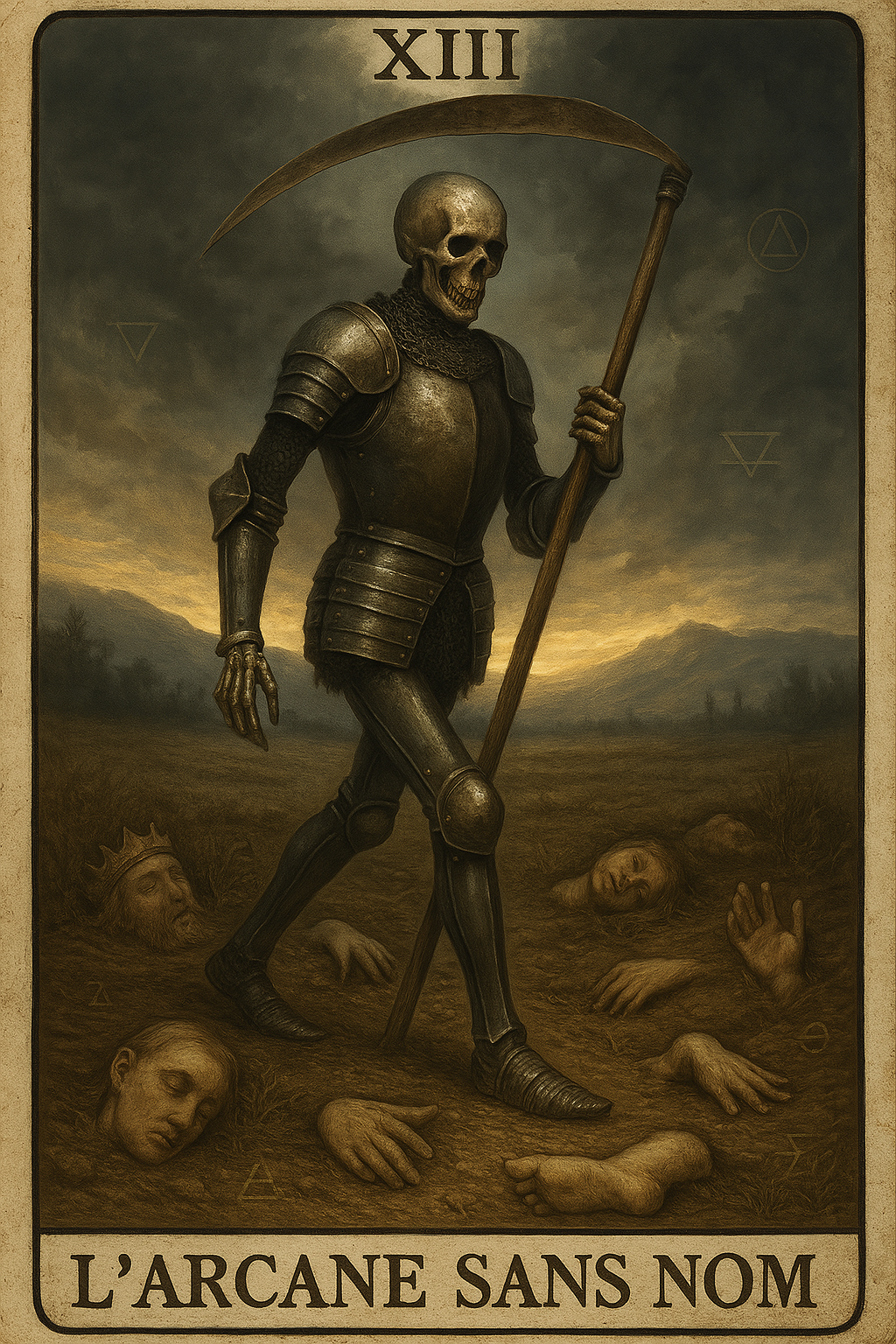 |
XVI – The Tower: The Ego Struck by Lightning
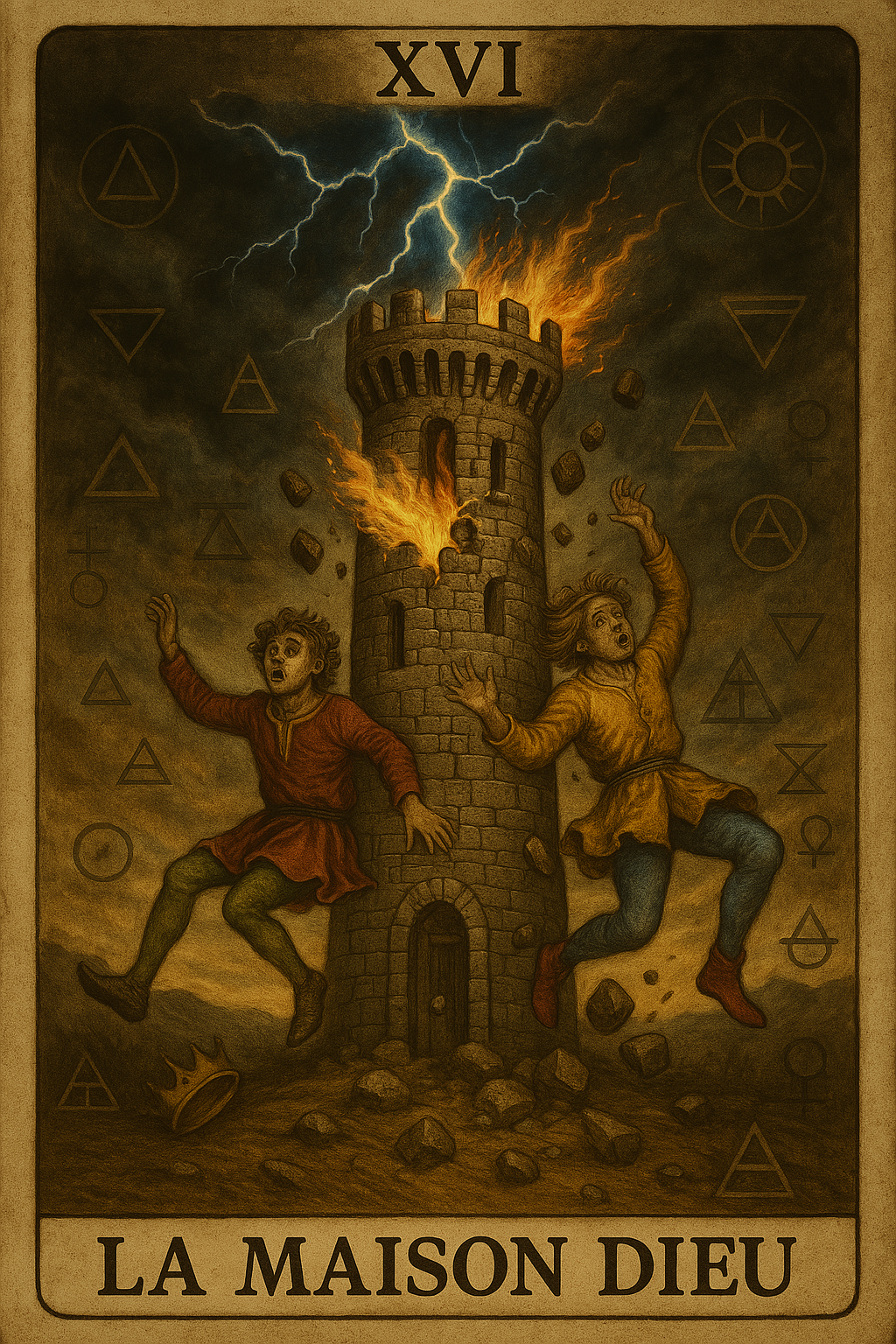 |
The Tower represents a sudden but liberating fall. A tower struck by lightning, figures falling into the void: all that was built on fragile foundations collapses. Prideful intellect and illusions of power or control are annihilated. Alchemically, this card symbolizes calcination: the phase where matter is exposed to intense heat to burn away impurities. It is the inner flame that destroys the old world to reveal the true one. This arcana is an invitation to accept chaos as an accelerator of transformation. Without this shock, the soul remains trapped in its mental structures. It’s a call to free oneself from the ego’s scaffolding to access a higher truth. |
XVII – The Star: The Regenerative Waters of Albedo
| After destruction comes comfort. The Star is one of the most benevolent cards in the Tarot. It shows a nude feminine figure pouring two amphoras into a river and onto the earth, beneath a starry sky. We are now in the Albedo, the alchemical phase of purification and harmonization. Water dominates the scene, symbolizing calm emotions, gentleness, and spiritual connection. Nudity symbolizes authenticity regained after the fall. The Star teaches the power of beauty, silence, and faith. It is the light after the storm, the consciousness reborn into a new clarity. The initiate, having faced darkness and breakdown, enters a time of deep spiritual healing. |
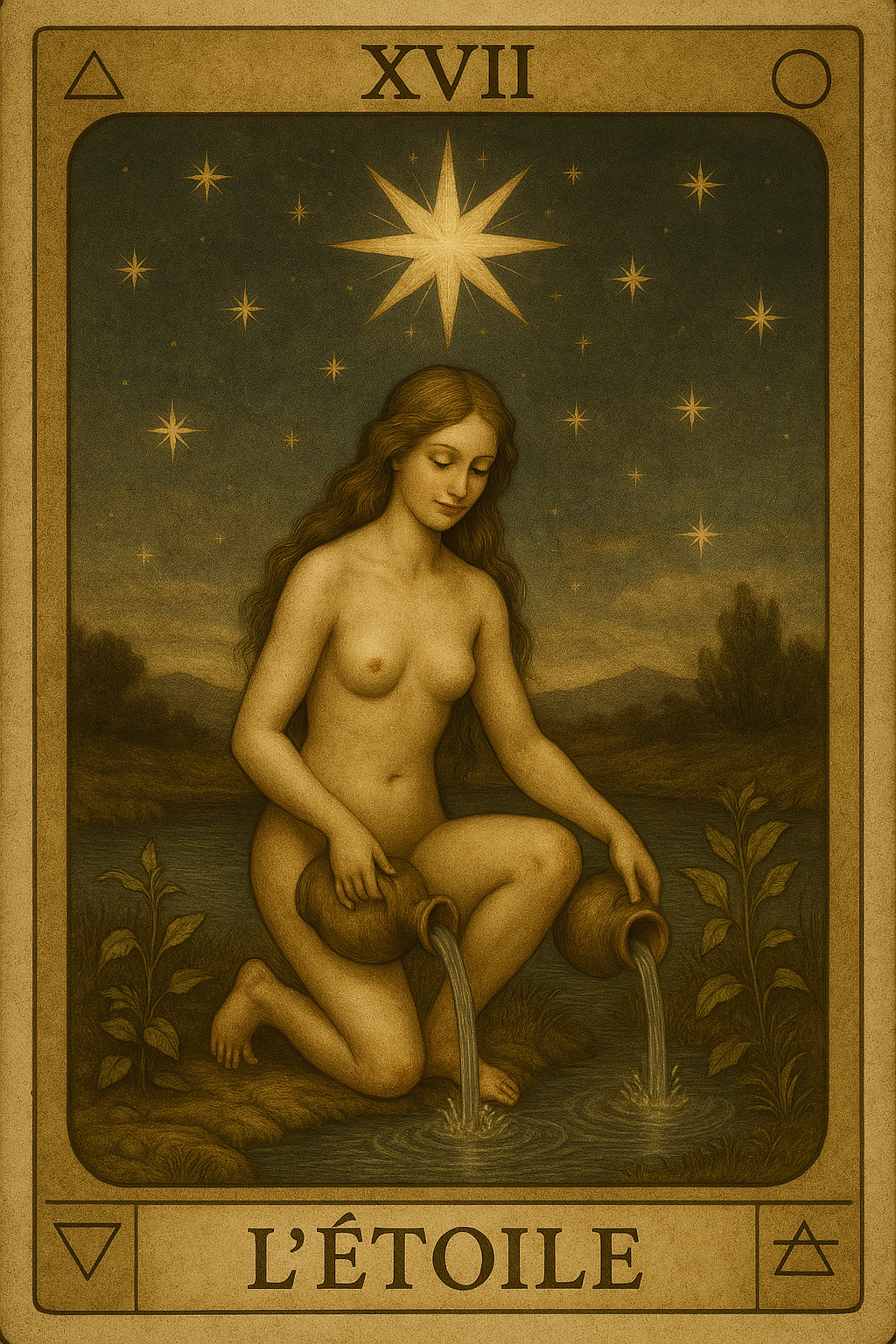 |
XX – Judgment: Resurrection and Fixation
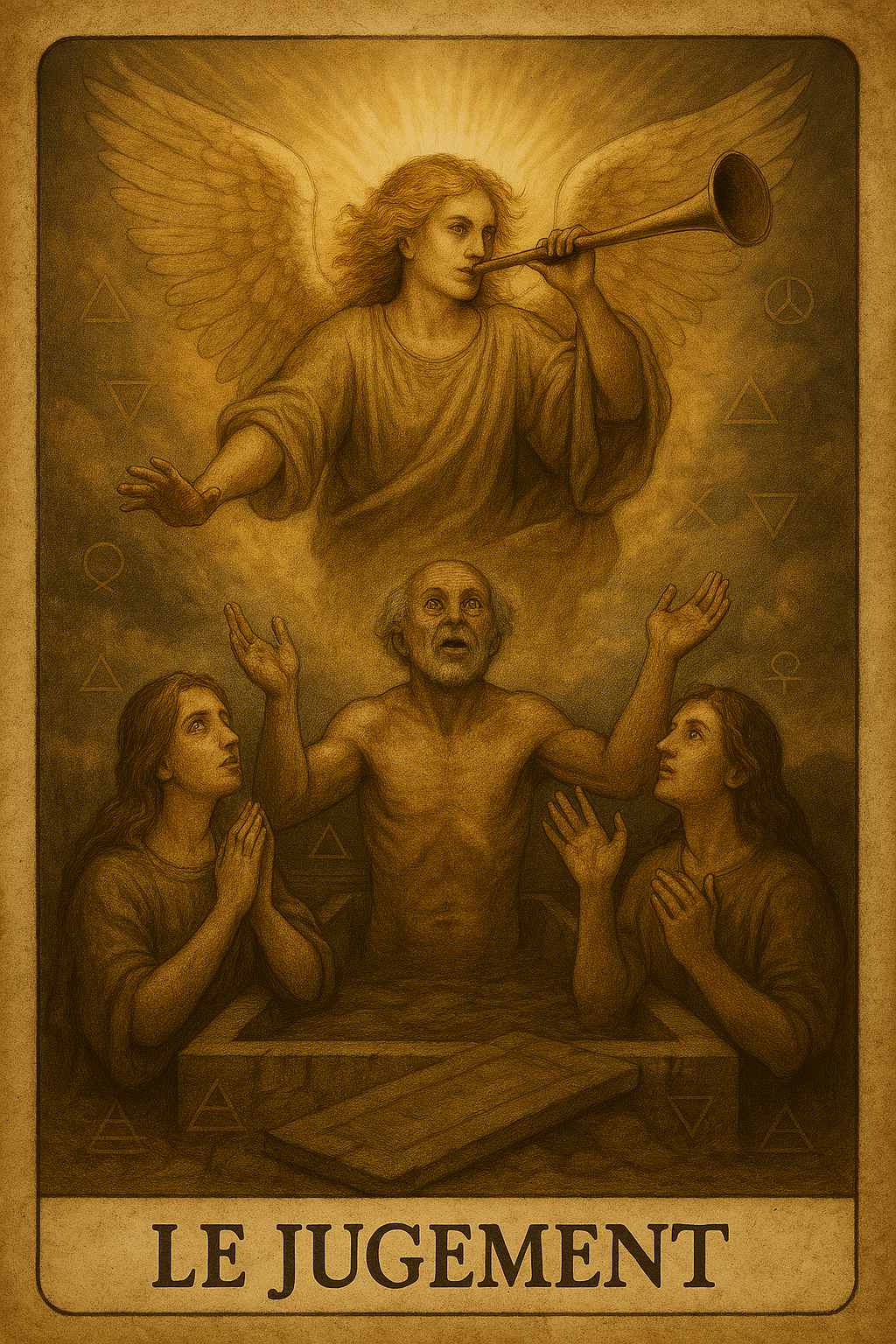 |
Judgment depicts a biblical scene: an angel blowing a celestial trumpet while the dead rise from their graves. Though religious in imagery, it is highly alchemical. We are now in the process of fixation: volatile energy is channeled and stabilized. The awakened individual finally hears the inner call, the voice of their higher self. They emerge from the tomb of unconsciousness, ready for full transformation. Judgment speaks of spiritual rebirth, understanding karma, and freedom from the cycle of symbolic deaths. It also represents the recognition of one’s life mission, one’s role in the universe. The angel is none other than the fire of Spirit, coming to animate sleeping matter. |
XXI – The World: Completion of the Great Work
| The World is the final card in the Tarot. It depicts an androgynous figure dancing within a mandorla, surrounded by the four living beings: the angel, the eagle, the lion, and the bull. These figures symbolize the four elements, the four evangelists, and the spheres of creation. In alchemy, this is the moment of Rubedo, the Red Work. The fire of Spirit has illuminated matter. The inner being is now reintegrated into the Whole, balanced between matter and spirit, masculine and feminine, shadow and light. This card represents the Philosopher’s Stone: the perfect knowledge of self and of the world. It also symbolizes mystical union with the divine, the cosmic dance of creation, and the return to harmony. |
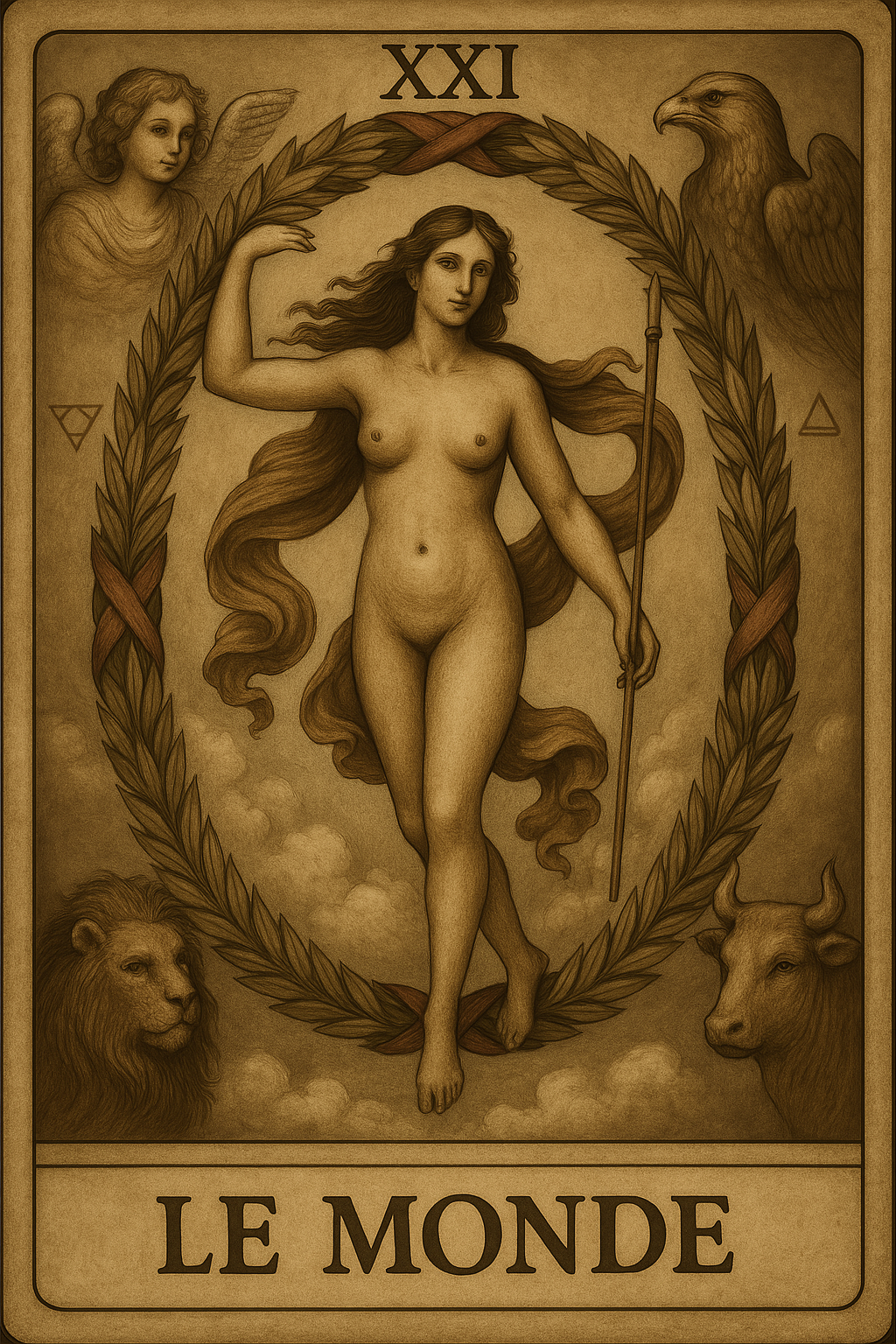 |
Tarot, far beyond a divinatory tool, emerges as a genuine initiatory path, a symbolic mirror of the soul’s transformation through trials, revelations, and metamorphoses. Each arcana, far from being a static image, becomes a living key, a gateway between the visible and invisible worlds, between the profane and the sacred, between matter and spirit.
Whether approached through the lens of the Tarot de Marseille or the Rider-Waite, its richness remains untarnished. It invites us into an intimate dialogue with our unconscious, our archetypes, our deepest aspirations. Its alchemical reading reveals an ancient knowledge, coded and passed down through generations, still resonating today as a call to awareness. As we travel the path from the Fool to the World, a full elevation unfolds — an inner Great Work, a slow and sublime alchemy of the self.











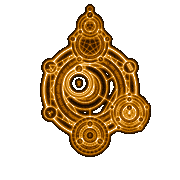





Comments : 0